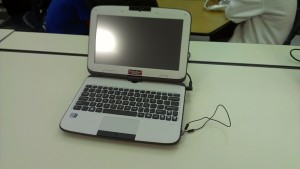Back to school brought some new changes at one of the local school districts in my area. They ditched the textbook. That’s right. No textbooks, anywhere. All the way from k-12, they have implemented iPads, and the combination netbook/tablet pictured here for EVERY student. I use a unit from Asus that is very similar, and it gets a lot of use in our youth ministry. The units are made for a company called DakTek that does a lot in the “School Computing” market. Street price is roughly $650 per unit, before any bulk discounts. It uses a lot of standard netbook hardware, as seen in an Acer Aspire ONE or an Asus EEE pc. The Screen is where it differentiates itself. It swivels around and folds onto the keyboard, creating a talet/ereader mode. The included stylus is attached via a cord, and has its on “home” built into the casing. It has a ruggedized casing that is resistant to drops and bumps. The keyboard is made from rubber with an anti-microbial coating.
way from k-12, they have implemented iPads, and the combination netbook/tablet pictured here for EVERY student. I use a unit from Asus that is very similar, and it gets a lot of use in our youth ministry. The units are made for a company called DakTek that does a lot in the “School Computing” market. Street price is roughly $650 per unit, before any bulk discounts. It uses a lot of standard netbook hardware, as seen in an Acer Aspire ONE or an Asus EEE pc. The Screen is where it differentiates itself. It swivels around and folds onto the keyboard, creating a talet/ereader mode. The included stylus is attached via a cord, and has its on “home” built into the casing. It has a ruggedized casing that is resistant to drops and bumps. The keyboard is made from rubber with an anti-microbial coating.
Thats the technical side of the story. Now for the human element. These students are being taught in a way that no generation before them has been taught in a public school. The district has abandoned even digital representations of textbooks due to the rising costs and need to buy the same book again every year for very small updates. The district has employed someone to help teachers write their own curriculum that utilizes the tablets and stays within the bounds of state education standards. This is a big change. The students have responded well for the most part.
How do you teach spiritual matters to students that are “pioneers” in this new territory of learning? I am learning as we go, but here are some principles that we are using:
1. BYOD works here – In the business world, Information Technology Administrators shudder when you mention BYOD (Bring Your Own Device). It makes headaches for them to support everyones different phone/tablet/laptop, etc. In our youth ministry, I encourage it. We have several in our ministry that make use of their iPod touch.
2. Using things that are cross-platform. The Bible App from Youversion is a great example of this. If it has a screen, you can pretty much get Youversion for it. I also make use of our website that can be utilized on Mobile, Desktop, or tablets/iPads. We also use Youversion’s Live Event platform to distribute notes and resources. Its very handy for when you have students that miss a week, then they can go online to get the notes and catch up.
3. Set clear expectations. Not every teenager is going to handle this the same, but in using technology in the hands of the students to help funnel spiritual matters to their heads and hearts, I expect that they are not going to be using it to play Angry Birds during the Bible Study.
4. Help make the technology accessible to everyone. We actually purchased a few tablets a couple years ago, when we saw this coming to fruition. I wanted to help students understand that they can use technology to help enhance their Biblical literacy and spiritual growth. This also helps make sure there are enough devices to go around when you account for the BYOD people.
I have not near covered all that is involved with using technology in teaching. However, I hope you understand that this is a fundamental change in learning that requires the church to be proactive, not reactive to be successful.
